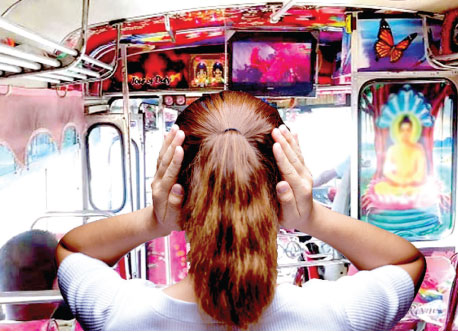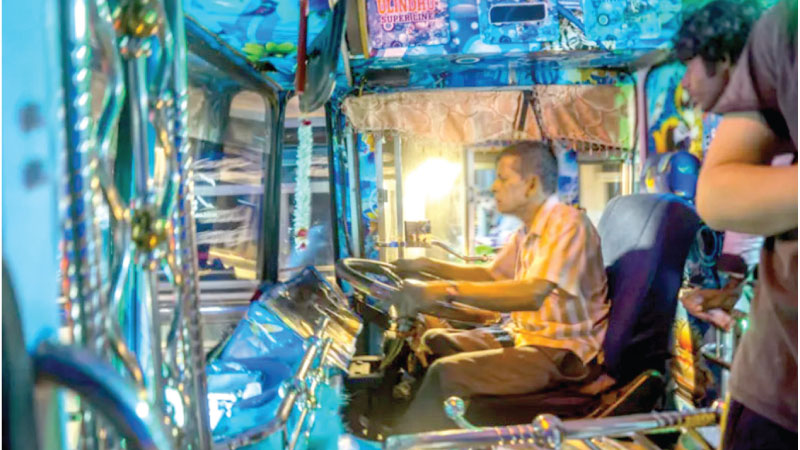 The Sri Lanka Transport Board (SLTB) has had quite the windfall — over just four days, it raked in a whopping Rs. 600 million during the Avurudu travel surge. Some 350 additional buses were rolled out to meet the holiday rush, with daily earnings peaking at around Rs. 200 million.
The Sri Lanka Transport Board (SLTB) has had quite the windfall — over just four days, it raked in a whopping Rs. 600 million during the Avurudu travel surge. Some 350 additional buses were rolled out to meet the holiday rush, with daily earnings peaking at around Rs. 200 million.
Both State-run and private buses were in overdrive during the 2025 New Year commute. The SLTB expanded its capacity, while private operators helped shoulder the demand. But not everyone was humming along — some long-distance passengers voiced concerns over overcrowding and inconsistent service. Yet, both systems remain vital. For millions, they’re not just convenient — they’re the only way to get around.
Still, there’s another ride-along passenger nobody asked for: the noise.
Riding the decibel express
For decades, loud music in buses has gone largely unchecked, evolving into a rolling audio assault that blurs the line between public transport and unsolicited entertainment. What used to be background tunes is now a full-volume concert at 8.00 a.m., often delivered through worn-out speakers or nightclub-grade stereo systems.
Yet, it’s important to note that those operating the buses — drivers and conductors — often face immense pressure to meet tight schedules and retain passengers, which fuels a culture of overstimulation rather than outright negligence. In fact, these very individuals are more vulnerable than passengers to the long-term effects of prolonged exposure to high-decibel environments.
And let’s not forget the driving itself — a performance art in its own right. Many drivers of these neon-lit, bass-thumping buses operate under relentless pressure to stick to near-impossible schedules, which results in, shall we say, creative interpretations of the road rules. Speeding through traffic lights like it’s a video game, overtaking on blind curves, all the while blasting music at nightclub volumes.
As of 2022, there were 9,807 private buses operating island-wide. And let’s just say, some of them come equipped with more neon lights, bass boosters, and decorative vinyl than an 80s disco revival. It’s no wonder the Government’s latest “Clean Sri Lanka” campaign — aimed at removing unauthorised modifications — has sparked both debate and resistance.
Government efforts
The National Transport Commission (NTC) implemented regulations prohibiting the playing of loud music in both private and State-owned buses. A volume limit was imposed to ensure passenger comfort, and a curated list of suitable songs was recommended for use during journeys. The NTC stipulated that only radio devices could be used within buses, and these should operate at levels that do not disturb passengers.
Unauthorised decorations and electronic displays that could hinder passenger comfort or safety were also prohibited by the present Government. Vehicle owners were given a three-month grace period to comply with these regulations. The police were instructed to take strict action against motorists using blaring horns. Fines ranging from Rs. 3,000 to Rs. 75,000 were introduced, depending on the severity of the offence.
Some felt these measures as long-overdue regulation. Others have seen this as meddling with youth culture and “freedom of expression” — as if turning down the speakers is an existential threat. Still, regulation seems to be the only path forward. It’s not that public buses are inherently bad. It’s that regulation is toothless, enforcement is patchy, and successive Governments have turned a blind eye. The real issue is the lack of will to balance public need with public health.
Face the music
Ah, that sound! Isn’t it just delightful? You didn’t ask for it, you certainly didn’t pay for it — but there it is, gifted to you like unsolicited advice from a loud uncle. Audible entertainment, generously offered by our bus drivers and conductors.
They operate their bus audio systems with the flair of DJs, offering an eclectic — and frequently high-volume — playlist. From syrupy Sinhala pop to folk tunes, golden oldies, baila, recorded non-stop local music concerts, Indian film songs, and the occasional Western chart-topper, it’s all in the mix. And by “audible entertainment,” we refer to the often overwhelming wall of sound that that beats the eardrum. .
Welcome to the world of “bus Sindu” — a uniquely Sri Lankan phenomenon where your daily commute transforms into a mobile concert you never signed up for. The bus isn’t just a mode of transport. Oh no — it’s a rickety, diesel-powered stage, and you’re in the front row, like or not.
And the DJ for this rolling rave? None other than the driver or the conductor. Their taste becomes the soundtrack to your daily commute. Whether you’re heading to work, school, or just trying to survive the ride, you’re part of the show now.

Blaring cacophony
Passengers, for their part, adopt a strange kind of collective identity — one forged in forced musical bonding and relentless decibels. They sit, stoic or resigned, enduring every window-rattling beat, as if it’s their civic duty to absorb both the bus culture and the noise pollution.
One might reasonably ask: does public transport now mean being held hostage by someone else’s blasting well over the 85-decibel limit prescribed by the WHO’s occupational noise exposure standards?
However, in keeping with the National Transport Commission (NTC) regulations and policies only a radio device can be used within the bus as audio equipment and at a level that would not disturb or upset comfort levels of the passengers. According to the NTC they have put into effect many actions to make certain that these regulations are followed.
A Commission official said they would not renew passenger service permits of those bus operators who violate these rules after investigating such complaints from the passengers who were disturbed by the noise in buses. Although we function with a limited capacity of staff to carry out inspections we do our level best to address these issues province by province, the official said.
Both private and SLTB bus transport remain essential, even when they blow right past acceptable standards on noise and regulation.
Some buses look like rejected props from a low-budget sci-fi film. And yes, nobody really asked for a mobile disco at 7 a.m.
Options
Private and SLTB buses together form the backbone of public transport For millions of commuters — students, workers, pensioners — they’re not just an option, they’re the only option. Trains are limited, taxis are unaffordable for daily use, and walking 30km isn’t exactly practical.
Sri Lanka simply doesn’t have the infrastructure for a mass transition to quieter, more disciplined alternatives. Light rail? Still a dream. Electric buses? Still on PowerPoint slides. Until systemic investment is made, these buses are here to stay. Private buses, for all their blaring music and flashing LEDs, offer high-frequency services on routes the SLTB often can’t cover. And the SLTB, for all its aging fleet and red tape, provides subsidised, more affordable rides — especially crucial for rural and low-income communities.
Come New Year, school holidays, or examinations, both private and SLTB buses ramp up operations. Without them, the country would grind to a halt, quite literally. No amount of noise complaints would drown out the chaos of a transport collapse. According to NTC statistics the country has a bus fleet of 19,862 of which 9,807 buses operate island-wide. Of this most of the private buses have been altered to maximise passenger capacity and improve aesthetics. These modifications has compromised essential safety features. For example, changes to the vehicle’s structure, like removing seats, altering the emergency exits, and adding silver bars and metal buffers, has hindered evacuation during emergencies and increase the casualties.
Subculture
The rise of heavily modified buses has taken shape over the past 10 to 15 years, evolving into a full-blown subculture. And like all good subcultures, this one thrives on two things: aesthetic excess and public indifference. Passengers, meanwhile, are treated to an imposed experience of retina-searing lights, deafening music, and decor. Like it or not, you’re part of the ride. While public debate simmers over removing these over-the-top modifications, it’s worth examining why certain groups — bus owners, segments of the youth, and those loud corners of social media — are staunchly opposed to tighter regulation.
The Government has undertaken several initiatives to address noise pollution in private buses, focusing on both regulatory measures and enforcement strategies.
In January 2020, the National Transport Commission (NTC) implemented regulations prohibiting the playing of loud music in private and State-owned buses. A volume limit was imposed to ensure passenger comfort, and a curated list of suitable songs was recommended for use during journeys .
These measures reflect the Government’s commitment to mitigating noise pollution in public transportation, aiming to enhance passenger comfort and public health.
The Government can’t just hit the mute button and walk away. It must tread carefully — crafting smart, enforceable policies that regulate or remove unnecessary modifications without sparking an all-out cultural rebellion. The impact of this bus subculture, especially on youth, is real and far-reaching. From shaping their aesthetic tastes to influencing how they perceive public space and identity, it’s more than just noise — it’s narrative.
Silence is enforceable
While the country’s public buses double as mobile concert halls — countries such as India and China have also grappled with the same issue, but unlike us, they’ve started hitting the mute button with actual enforcement.
But the noise pollution in these buses are caused by the passengers, and not by bus conductors and drivers. In Karnataka, passengers are prohibited from playing music or videos on mobile speakers. Conductors have the authority to ask non-compliant passengers to leave the bus — a rare but refreshing example of giving authority a real bite. Mumbai’s best buses can eject passengers who play music or talk loudly on phones, thanks to specific transport regulations.
Chennai’s MTC buses have banned crew members from playing music altogether. Amplifiers and Bluetooth devices have been physically removed from vehicles — proving that silence isn’t just golden, it’s enforceable.
China has followed suit, especially in its urban hubs: In Shanghai, as of late 2021, a ban on loudspeakers and audio devices was extended from subways to public buses. The aim? A more peaceful ride for all. Commuters, for the most part, welcomed the move — although enforcement is still work in progress, especially with headphone-averse riders.
As pointed out by NTC officials, loud music continues to be a “feature” of bus rides, thanks to low enforcement, cultural acceptance, and audio systems that seem to have been independently installed despite regulations such as allowing only radio at non-disruptive volumes — actual implementation remains patchy at best. If other countries can enforce peace and quiet on public buses, the Government may want to consider turning inspiration into action.









